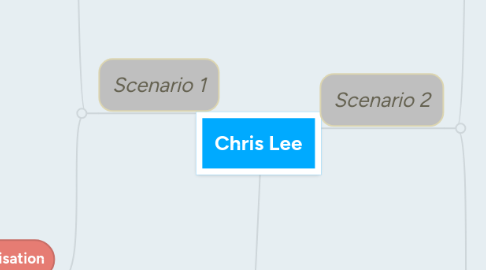
1. Risk factors of mental illnesses
1.1. Psychosocial problems
1.2. Physical illness
1.3. Medication
1.4. Family history
2. Personal information
2.1. Work
2.1.1. stressed
2.1.2. work late after midnight
2.1.3. architect in large company
2.2. Family
2.2.1. parents and elder brother: lives in Australia
2.2.2. elder sister: lives apart in HK
2.3. Age
2.3.1. 25
2.4. Background
2.4.1. live in HK
2.4.2. normal childhood & education
3. Scenario 1
3.1. Chief Complaints
3.1.1. insomnia for 3 days
3.1.2. delusion
3.1.3. stress
3.1.4. auditory hallucination
3.1.5. delusions
3.2. Hospitalisation
3.2.1. ordinance
3.2.1.1. voluntary hospitalization
3.2.1.1.1. 7 day notice of discharge application
3.2.1.2. compulsory observation (F123: detention 7 days)
3.2.1.2.1. voluntary
3.2.1.2.2. Extended compulsory observation (F4: detention 21 days)
3.2.2. communcation
3.2.2.1. Strategies
3.2.2.1.1. Be respectful
3.2.2.1.2. If hallucination: don't argue with /pretend to understand
3.2.2.1.3. If paranoia: maintain body space
3.2.2.1.4. Don't assume low intelligence
3.2.2.1.5. Don't lie
3.2.2.2. Skills
3.2.2.2.1. Listening
3.2.2.2.2. Non-verbal communcation
3.2.2.2.3. Silence
3.2.2.2.4. Reflecting skills
3.2.2.2.5. Paraphrasing
3.2.2.2.6. Summarizing
3.2.2.2.7. Questioning
3.2.3. Assessment
3.2.3.1. Admission assessment
3.2.3.1.1. admission notes
3.2.3.1.2. Assessment on physical and mental condition
3.2.3.1.3. Assessment on psycho-social and functional status
3.2.3.2. Brief psychiatric rating scale
3.2.3.3. stress
3.2.3.4. insomnia
3.2.3.5. sleeping history
3.2.3.6. mental status examination
3.2.4. management
3.2.4.1. Hallucination
3.2.4.1.1. Use simple wordings
3.2.4.1.2. Provide a quiet non-stimulating environment
3.2.4.1.3. Avoid giving choices. It would increase anxiety
3.2.4.1.4. Provide reality orentation
3.2.4.1.5. Obtain feedback frequently
3.2.4.1.6. Arrange psychiatric consultation
3.2.4.1.7. Make sure medication taken correctly
3.2.4.2. Delusion
3.2.4.2.1. Educate patient's family on delusion
3.2.4.2.2. Reduce triggering factors
3.2.4.2.3. Encourage reality-based activities
3.2.4.2.4. Use gesture instead of touch
3.2.4.2.5. Don't argue with patient's belief
3.2.4.2.6. Consider restraint if indicated
3.2.4.3. Stress
3.2.4.3.1. Avoid unnecessary stress
3.2.4.3.2. Alter situation
3.2.4.3.3. Adapt to stressors
3.2.4.3.4. Spend time on releasing stress
3.2.4.3.5. Healthy lifestyle
3.2.4.4. Safety problem
3.2.4.4.1. Apply restraint
3.2.4.4.2. reduce noise/ stimulation
3.2.4.4.3. Risk assessment
3.2.4.4.4. Well-trained staff
3.2.4.4.5. Reassure patient
3.2.4.4.6. use firm & clear statement to stop violence
3.2.4.5. Insomnia
3.2.4.5.1. acupressure
3.2.4.5.2. medication
3.2.4.5.3. dietary measures
3.2.4.5.4. exercise
3.2.4.5.5. good sleep hygiene
3.2.4.5.6. combination therapy
4. Scenario 2
4.1. Progress
4.1.1. diagnosis
4.1.1.1. schizoprenia
4.1.1.1.1. definition, characteristic, risk factors, complications
4.1.1.1.2. subtypes
4.1.1.1.3. Comparison
4.1.2. socially isolated
4.1.3. seldom talk
4.1.4. more suspicious to others
4.1.5. persisting auditory hallucination
4.2. Psychiatric acute unit
4.2.1. Treatment
4.2.1.1. pharmacological
4.2.1.1.1. Risperidone
4.2.1.2. non-pharmacological
4.2.1.2.1. Cognitive behavioral therapy
4.2.1.2.2. Family intervention
4.2.1.2.3. Skill training
4.2.1.2.4. Contingency management
4.2.1.2.5. Counseling
4.2.1.2.6. Psychodynamic psychotherapy
4.2.1.2.7. Token economy
4.2.1.2.8. Transcranial magnetic stimulation
4.2.1.2.9. Motivation intervention
4.2.1.2.10. Art therapy
4.2.1.2.11. Supportive therapy
4.2.1.2.12. Cognitive remediation
4.2.1.2.13. Adherence therapy
4.2.1.2.14. Psychoeducation
4.2.2. Nursing care
4.2.2.1. Manage Side effects of drugs
4.2.2.2. Social Isolated
4.2.2.3. Suspicious
4.2.2.4. Voice
4.2.3. Rapport building
4.2.3.1. Communication and involve Family members
4.2.4. Discharge plainning
4.2.4.1. medication management
4.2.4.1.1. education
4.2.4.1.2. follow up with medication intake
4.2.4.2. activities of daily living
4.2.4.2.1. identify needs
4.2.4.2.2. education, explanation & documentation
4.2.4.2.3. areas
4.2.4.3. rehabilitation
4.2.4.3.1. Enhance coping
4.2.4.3.2. Foster socialization
4.2.4.3.3. Enhance self-esteem
4.2.4.3.4. Reduce relapse episodes
4.2.4.4. community support
4.2.4.4.1. types
4.2.4.4.2. services
4.2.4.5. family support
4.2.4.5.1. Consideration
4.2.4.5.2. Encourage family involvement
4.2.4.5.3. Education
4.2.4.6. physical health care
4.2.4.6.1. recognize physical illness & seek medical care
4.2.4.6.2. comfortable with talking to GP
4.2.4.6.3. regular physcial checkups
4.2.4.6.4. provide information to access services
4.2.4.7. basic needs
4.2.4.7.1. financial
4.2.4.7.2. residential services

